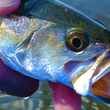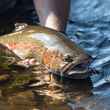It is commonly said that every twentieth rock in a given stream has an adipose fin. The point here is, of course, that every twentieth time you think you've snagged or hit a rock -- you've actually encountered a fish. While it's doubtful there's anything but anecdotal evidence backing the statistical content of this saying, the point it attempts to make remains solid: if you think you're not getting enough hookups when nymphing, one of the most likely reasons is that you're not setting the hook often enough.
Most fisherman that are highly successful at nymphing share a common behavior: they're setting the hook constantly. And this is what you're supposed to be doing, isn't it? Most of us are taught, or teach, indicator nymphing the same way: watch the indicator drift, if it does anything other than float along the surface minding its own business, set the hook.
And while this is what most fishermen think they're doing when nymphing, the reality is that what most fishermen are doing is applying their own interpretation of this rule, instead of following it to the letter. This is where the idea of setting the hook every time you think you've snagged or ticked a rock comes in. Sure, you may think your nymph or line encountered a rock, or bounced on the bottom, or that the current is doing something funky to your nymph or indicator. The truth is, however, that even in gin clear water when you can see your nymph, it is difficult and often impossible to be sure. You shouldn't be making guesses, especially given that the cost of being wrong is often missing a hookup.
The consequences of setting the hook too often? If you're setting the hook properly, probably very minimal. Your set should be deliberate, but not overly dramatic. A quick but relatively light hook set that moves the line and your fly downstream is the way to go. If there's nothing there? So be it. Your fly should go right back to drifting along, for the most part in the same lane you placed it in before you struck, ready to encounter the next fish.
While fishing for redside trout on Oregon's Deschutes River friend and guide Tom Larimer, Tom told the story of a client who was a first time fly fisherman and one who took the nymphing 101 explanation given above to the extreme. After watching this novice fisherman attempt a few drifts in which he was "setting the hook on every little twitch or wiggle" the indicator made, and just as he was about to instruct his client to back off the given rules a bit, something happened: he started catching fish. Catching fish as a result of setting the hook based on changes in the indicator's behavior that wouldn't even have caused the guide to strike. Not only does this go to show that guides can learn something from even first-time clients from time to time, it goes to show that you really can't set the hook too often.
Don't let interpretation creep into your nymphing. Unless you're 100% certain that the indicator is behaving as you expect it to, set the hook. Don't guess. Set the hook. You'll have an increased hookup rate to thank for it.






























Comments
durant replied on Permalink
Yep. I actually know I'm not setting the hook as much as I should be when nymphing, yet I continue to do it anyway.
I need someone standing behind me smacking me in the head everytime I should have set the hook but didn't.
Jonathan R Schmidt replied on Permalink
Great advice. I lost a few bigger fish recently while nymphing. They seemed to not be hooked well obviously. Should I have set the hook earlier or does that just happen? Were they starting to spit the hook when I hooked them and then got off because I didn't set early enough? Or is that just the price to pay for fishing small nymphs?
DDon replied on Permalink
We all do it .. who wants to destroy a perfect drift just because you might catch a fish? ;)
ginkthefly replied on Permalink
Haha. Totally true. I've definitely caught myself thinking along those lines.
Pages